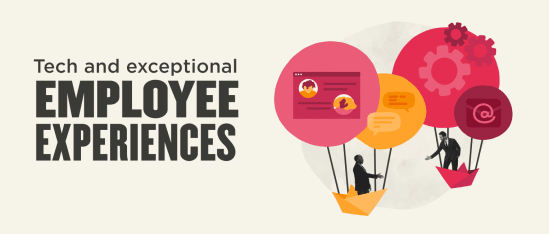As the world of work continues to evolve amid a shifting social and economic landscape, leaders face the ever-present challenge of building systems and choosing tools that meet the demands of today’s workplaces.
For organizations with collaborative multi-national workforces—and for companies looking to expand internationally in the near future—deploying the right integrated tech stack can drive productivity, efficiency, resiliency, and engagement. Choosing the right tools helps future-proof internal processes and pave the way for long-term success.
When HiBob teamed up with two partner organizations, I had the privilege of moderating a live panel discussion, “The Great Reconnection: How future-ready organizations use connected systems to drive exceptional workplace experiences.” The panel of experts included:
- Toby Hough, people and culture director, EMEA at HiBob
- Lander Ghoos, VP of people at Rydoo
- Kelly Jewison, head of product partnerships and business development at TravelPerk
They addressed the realities of workplace collaboration in growing organizations, how tools can support cultures of belonging and engagement, and why it’s valuable to the business to break down barriers between teams.
A 2022 snapshot: The state of workplace collaboration
The primary challenge fast-growing organizations face is limited time and resources to implement company-wide tools and systems—even while HR and other leaders have made great strides toward many workplace improvements.
“The day-one reality is that we do a really great job of building teams quickly, of hiring amazing people, of giving them a great culture and a sense of belonging,” Toby said, adding that the byproduct of such quick growth is often siloed systems that work well for an individual team but do little to connect teams to one another.
He says it doesn’t stem from any ill will but from how high-growth environments often stretch resources thin.
“There’s always that feeling in the back of your mind that one day all of these systems will be speaking to each other better, that all of our departments will be really in sync,” he said. “But we’re not quite there yet because we’re still growing. We’re still building.”
For international teams, even simple systems—like procedures for reporting expenses, for example—can quickly become complicated as organizations respond to rules and regulations for multiple locations.
“You need to be compliant in places you never expected to be compliant for,” Lander said.
Break down barriers to forge connected workplaces
Whether workplace silos exist between functional teams within the organization or between locations in different countries, those barriers limit the potential of a thriving workforce.
“Collaboration between different internal stakeholders, between different business organizations, is crucial to the success of a business,” Kelly said. “Opening up, being transparent, and figuring out how to work together, talking about your different objectives and how they can align and overlap—that’s massively impactful to how you grow your business.”
When leaders at HiBob noticed a disconnect between internal teams, they deliberately targeted a group of managers to create a stronger sense of connection.
Toby described how HR leadership got managers from across the company together and emphasized the need for collaboration. “If you don’t all know one another as individuals,” he told them, “but also what your teams are working on, the different priorities, how those cross over—then there’s no way your team members will feel that.”
They convened a recurring virtual forum for this group of international leaders and tasked them with cocreating the objectives of the group. More than a year later, the group is still meeting and working to break down silos within the organization.
Lander made a point of saying that external collaboration—through partnerships and tool integrations—can be just as important as internal connections.
“You cannot do it all or be the best at everything,” he said. “You have to pick your class and try to be as good as you are there, and then partner up with the right companies so that in the end, it will all come together and create the right flow.”
Leaders can lean on tools to boost thoughtful engagement
Implementing a tech stack of integrated tools is about more than creating efficiencies at the leadership level—even small details can significantly affect engagement, culture, and a sense of belonging at work.
“Interconnected tools—or just tooling in general—can really help us solve the problem [by] taking away white noise,” Lander said, and “having people focus on what really matters for them, what really provides value not only to the company but also to themselves.”
International organizations must pay attention to how tools and processes affect the whole team, not just the majority of people who may work in one country.
Leverage tech to support your international teams
Basic tools like Slack and Google Calendar have features to support international teams if they are implemented correctly. For example, at HiBob, we employ people around the world who work in different time zones, and about half of our workforce is located in Israel, where Sunday is a regular workday.
Before sending a Slack message, the platform notifies the sender of the recipient’s local time, which may prompt them to queue the message for later delivery. And Google Calendar can provide similar information when scheduling a meeting that may fall outside the recipient’s working hours.
“If we just rely on ourselves to constantly think about our global workforce, we’re not going to always make the right decision, and that won’t be intentional,” Toby said. “We don’t need to rely on ourselves. We can rely on great software that points us in the right direction, and people notice that.”
People also notice small changes—such as ensuring expense tracking software is configured to the correct units and reimbursement rates for their location or including multiple personal pronoun options in personnel profiles—that establish a strong sense of belonging among a growing workforce.
Recommended For Further Reading
Integration impacts the workplace experience
Manual systems may have their place early on, but as organizations scale, those processes must be left behind or risk contributing to workplace frustration and even attrition.
“We don’t want to overcomplicate things. We want to simplify things. So integrating systems is a natural course for a company,” Kelly said.
Integrating processes like travel and expenses opens up many possibilities, even as it eliminates pain points like human error or time spent chasing down that one team member who hasn’t submitted their receipts.
“You’ve got to keep streamlining these processes and these procedures to help with the adoption of your team,” he continued. “The easier you make it, the more people are going to use it.”
High adoption rates free up time and resources to address compliance needs: Systems that sync seamlessly can provide leaders with real-time data to make critical business decisions—shifts that ultimately impact the bottom line.
“Happy employees, productivity, and efficiency,” Lander said. “It just goes hand-in-hand.”
High-performance tools help your people thrive
Choosing and connecting high-performance tools sends a deliberate message to people about how much the organization values them and wants them to thrive, says Toby.
“When you’ve thought about your entire workforce and how you choose and implement these systems—which is recognized and noticed—you get the wonderful business efficiencies of different teams speaking to one another,” he says. “Very few teams in any modern connected business can afford to work in isolation.”
This article is based on the live panel discussion “The Great Reconnection: How future-ready organizations use connected systems to drive exceptional workplace experiences.” Watch our full conversation for deeper insights into creating better workplaces in today’s work landscape.

From Breanne Murphy
As head of partner marketing, Breanne collaborates with HiBob technology partners from all over the world, amplifying the power of connected systems through strategic marketing programs. When she's not creating marketing magic, she spends her free time exploring NYC's new restaurants, galleries, markets, and coffee shops with her husband and pup.

